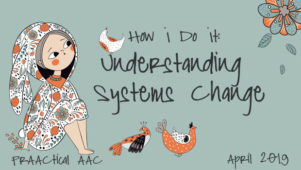Call for Action: Public Comments on AAC Device Funding

Chances are that most of our US-based SLPs have heard about the funding challenges with Medicare. We now have only a few more days to make our voices heard to support clients with AAC needs. If you haven’t already submitted public comment, please take the time to help in these advocacy efforts.
Medicare (CMS) currently is reconsidering its National Coverage Decision (NCD) for Speech Generating Devices (SGDs). As part of that process, CMS will allow interested members of the public to submit comments about future Medicare SGD coverage until December 6, 2014. The information that follows was prepared by the Medicare Implementation Team, an ad hoc group of AAC clinicians, researchers, advocates, educators, manufacturers, etc., many of whom worked on the 2001 NCD.
FOLLOW THESE 5 SIMPLE STEPS TO SUBMIT A COMMENT TO CMS.
1. Review the 8 PROPOSED COMMENT AREAS below that are critical to include in a revised NCD for SGDs.
2. Copy the Comment Areas so you can PASTE them to the Comment Section on the CMS website. We recommend pasting the 8 comments to a Word Document first so you can add personal information and experiences that strengthen your submission and then paste those into the comment section. (Of course, you may also chose to select fewer of these comments, or only one, if you wish to concentrate your personal comments on a particular point. Also, you can submit several times, each with the focus on one comment, or just a few comments.)
3. Click here to visit the CMS website in a new window. Note: Before you will be allowed to enter any text, you will need to click the link to view the “CMS PHI Posting Policy” and then check the box next to the statement: “I have read and understand the CMS policy regarding redaction of PHI”
4. Fill in the form on the CMS website and PASTE your comments to the “Comment” box. The fields with the redasterisks are mandatory!
5. When you are satisfied with your comments, click the orange SUBMIT button at the lower right corner of the page. Your comments will not be recorded until you click SUBMIT!
DEADLINE FOR COMMENTS IS DEC. 6, 2014
Copy the following into your document and then paste into the Comment box on the CMS site
PROPOSED COMMENTS
Thank you for the opportunity to provide input on Medicare policy regarding speech-generating devices (SGDs).
SGDs are a vital means of communication for individuals with speech and language impairments, often with co-occurring severe physical impairments. They enable people with complex communication needs (CCN) to live more safely and independently, maintain important societal and family roles, and communicate important personal and medical decisions. With respect to the National Coverage Decision (NCD), CMS should:
1. Continue to allow SGD manufacturers to use off-the-shelf technology as SGD hardware.
In the May 2001 interpretive clarification to the 2001 NCD, Medicare expressly authorized coverage of computer-based SGDs as long as they were modified to function as “dedicated speech devices.” As Medicare reconsiders its SGD coverage and guidance, it is important that this option continue. Presently, several important SGDs make use of off-the-shelf or consumer computer based technologies. As required, these devices have been modified to meet Medicare requirements for coverage.
The size, weight, shape and access method are all important factors in the evaluation process for an SGD and off-the-shelf technologies provide additional options. SGD coverage should continue to extend to devices that are computer based, including those that rely on off-the-shelf hardware and components, as long as the devices meet the other requirements for coverage stated in the NCD.
2. Keep access to capabilities, features and functions that support device function as an SGD.
Medicare covered SGDs: dedicated speech devices, used solely by individuals with severe speech impairment, require several capabilities, features, and functions to operate effectively and efficiently as SGDs. The 2001 NCD did not restrict any of these operational characteristics of SGDs, including
- Enabling the SGD manufacturers to connect wirelessly to devices to provide technical support, troubleshooting, and software corrections and upgrades (independent of unlocking);
- Enabling photographs to be installed onto the device display, either through transfer from another device, or through a built-in camera; and
- Enabling copying and storing of device contents to protect against loss if the device malfunctioned or was sent for repair.
Some of these device features are not within the client’s control, and none add costs to Medicare.
The Medicare “coverage reminder” (Feb. 2014) specifically referred to “wireless” capability as disqualifying for Medicare coverage and payment and its text raised questions about other similar features. Although the “coverage reminder” was withdrawn on November 6, Medicare should state clearly and confirm that any capability, feature or function that enhances or supports device operation as an SGD will continue to be covered.
3. Continue to allow SGD manufacturers to include environmental control capability.
SGDs have had the capability to enable users to operate external systems that can control lights, appliances, door openers, and home electronic devices, and access external alarm systems since before the 2001 NCD was developed and have continued to include these capabilities. These capabilities are generally referred to as “environmental control” or “electronic aids to daily living”. The 2001 NCD does not restrict these environmental control capabilities that do not affect the primary or customary use of an SGD, and are not useful to an individual in the absence of an illness or injury. This capability is available at no additional cost to CMS. Instead, the ability of an SGD to operate environmental control functions requires home and appliance modifications, at substantial additional expense, paid for by clients.
Environmental control capabilities provide important benefits to clients. They aid safety by:
- Providing users the ability to access medical alerting systems to call for help
- Allowing users to control access to the home, for example to allow access to the home for emergency responders
These capabilities also promote independent living by:
- Enabling users to be left alone
- Enabling independent access to care at home
- Providing the ability to maintain family and parental roles
- Enabling the ability to pursue volunteer or community activities
The Medicare “coverage reminder” (Feb. 2014) specifically referred to “environmental control” capability as disqualifying for Medicare coverage and payment. Although the “coverage reminder” was withdrawn on November 6, the NCD should state clearly and confirm that environmental control capability will continue to be covered.
4. Continue to allow SGD manufacturers to provide phone control as an SGD feature.
A number of SGDs have the capability of connecting to telephone systems so that voice and text messages can be sent and received automatically through SGDs. Access to this capability enables telephone use by individuals who cannot place, answer or end calls physically or by voice. Like environmental control, the 2001 NCD does not restrict this SGD capability and accessing it does not result in any additional cost to Medicare.
Examples of why phone control is essential include:
- The person who uses an SGD needs immediate means to call (send information) for medical emergencies, personal safety, and in case of disaster
- Managing communication about health care appointments and transportation to health care appointments
- Enabling users to receive information about disasters and emergency actions
- Enabling users to receive and respond to safety and emergency alerts
The Medicare “coverage reminder” (Feb. 2014) specifically referred to “cellular communication” capability as disqualifying for Medicare coverage and payment. Although (1) “phone control” is not “cellular communication” capability, (2) SGDs typically do not include “cellular communication” capability, and (3) the “coverage reminder” was withdrawn on November 6, the NCD should clearly confirm that phone control capability will continue to be covered.
5. Authorize manufacturers to unlock SGDs: Allow upgrades to provide access to non-speech functions.
Medicare should allow users to unlock an SGD to allow access to non-speech capabilities, such as email and web browsing. Unlocking is consistent with the 2001 NCD. From 2001 – 2014 unlocking was allowed because the devices were client-owned equipment and Medicare policy allows modifications to client-owned equipment as the client chooses. Because of the payment rule change to capped rental, effective April 1, 2014, access to unlocking must now be based on other authority, such as DME upgrades.
Clients who elect to unlock their devices impose no additional costs on Medicare. Also, unlocking provides benefits in addition to, not instead of the device’s role as a speech generating device. A recent survey conducted by the Medicare Implementation Team, an advocacy group committed to maintaining SGD access for Medicare beneficiaries, found that Medicare recipients with unlocked SGDs use face-to-face communication (speech) more frequently than internet-based communication. Speech is still the primary and customary use of SGDs, even when they are unlocked.
Many Medicare recipients use unlocked devices to support independence and family and social roles. Examples include:
- Calling for help in an emergency using a text-to-911 or instant message relay service
- Enabling users to receive and respond to safety and emergency alerts
- Sending an instant message to a caregiver in another room to request assistance
- Accessing medical records, schedule appointments, and communicate with healthcare providers via secure online healthcare portals
- Participating in tele-health visits with healthcare providers when travel to a clinic is impossible
- Using email to communicate with paid caregivers about scheduling, clarification of caregiving tasks, or other topics
- Accessing online user guides and technical support for training or troubleshooting with the SGD
- Enabling remote technical support, trouble shooting and device repair.
- Downloading page sets for use with the SGD’s communication software
- Keeping in touch with family and friends who live far away or are otherwise unable to visit
- Participating in online support groups or patient communities such as PatientsLikeMe
One outcome of the reconsideration process is that the NCD should state that SGDs can be upgraded at client expense to provide access to non-speech generating capabilities.
6. Keep coverage of eye tracking accessories.
Eye tracking technologies have been available since before the 2001 NCD was written, and have been covered uniformly from 2001 when the NCD went into effect until late 2013. Since then Medicare decision makers have been denying eye tracking accessory claims, stating they are not covered.
Eye tracking technologies should not be considered different from other accessories needed by people with physical limitations. Eye tracking modules are only used by people with significant physical disabilities who are unable to use other access methods. Denying coverage of eye tracking technology leaves such individuals unable to communicate.
7. Update the SGD HCPCS codes.
The 2001 NCD text describes the HCPCS “codes” that were initially assigned to SGDs and were used by Medicare (and other funding programs) for payment purposes. However, since 2001, the SGD codes have been changed and the NCD text is now both incomplete and incorrect.
- Incomplete because no mention ever was made of the codes for SGD mounts or SGD accessories.
- Incorrect because one of the digitized speech output device codes was split into 3. Instead of 4 device codes, there are now 6.
The reconsideration process gives Medicare the chance to update and correct the SGD code descriptions and to insert the omitted code descriptions for SGD mounts and SGD accessories. These mounts and accessories are crucial to ensuring that individuals can consistently access their SGDs to communicate in all environments.
8. Keep the option for coverage of either a dedicated SGD or for SGD software:
In the 2001 NCD, Medicare recognized that both a dedicated SGD and SGD software that would be loaded onto a device the client already owned were appropriate for coverage. These choices must be maintained.
For some clients, SGD software, not a fully dedicated built-for-purpose SGD, satisfies a person’s communication needs. The SGD software may run on existing consumer computing products that a Medicare beneficiary already owns, allowing for unique customization and resource efficiency. This option also is cost-efficient for Medicare.
However, other Medicare beneficiaries with speech impairments can only get their communication needs met with a dedicated SGD. This funding benefit should also be maintained.
- Dedicated built-for-purpose SGDs are configured and engineered to provide specific features that meet the needs of a variety of communication challenges not satisfied by SGD software alone.
- Dedicated SGDs are built to be durable, more easily heard in loud environments with high output speakers, easily mounted on wheelchairs and tables, and provide robust language representation options.
- Dedicated SGDs are adaptable for alternative access methods, such as head control, eye control, or switch scanning. Many people with communication impairments have co-occurring severe physical disabilities that leave them unable to use a standard mouse, keyboard, or touch screen. These individuals would be unable to use SGD software on a computer or tablet without alternative access options.
- Dedicated SGDs arrive ready to use as a packaged DME product, whereas SGD software requires the purchase of hardware that may be unaffordable or stress the financial resources of many Medicare beneficiaries.
For these Medicare beneficiaries, who have physical impairments that now or that may progress to require use of mounting systems and access aids, and who lack the resources to purchase necessary hardware with their own funds, covering only SGD software and not dedicated SGDs would result in an inability to communicate. To avoid these harmful restrictions, CMS must continue to allow funding options for both dedicated SGDs and SGD software.
Reprinted with permission from the Patient Provider Communication Network.
Filed under: PrAACtical Thinking
Tagged With: advocacy, CMS, funding, Medicare, patient provider communication
This post was written by Carole Zangari




